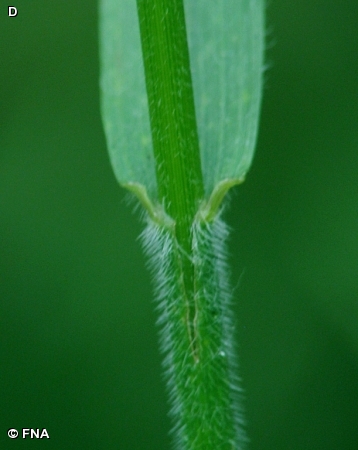
Slender, bunched native perennial with upright or leaning stems 2 1/2 – 5 feet tall. Leaves are often softly hairy, especially above. There are no more than 4-6 leaves per stem. Soft, thin hairs are present on the leaf sheaths and stems (D). Stem hairs are most dense about the nodes, which are visible and not obscured by the leaf sheaths (E). No ear-like appendages, or auricles, are present at the leaf base in this species. The flower cluster is an open, drooping 4-10 inch panicle bearing spikelets up to 1 inch long, each with 4-8 florets (A). The dried stems and empty flower clusters are seen well into the fall and winter (F).
Upland and floodplain woodlands. At Fontenelle Forest Canada Brome is common on Cottonwood and North Stream Trails and inside the third loop of the Boardwalk. It is uncommon at Neale Woods along Neale and Columbine Trails.
Another woodland brome with drooping panicles, Ear-leaf Brome (Bromus latiglumis), flowers in August and September, well after Canada Brome has flowered. Ear-leaf Brome also is leafier with more than 10 leaves per stem and has auricles at the base of the leaf blade. Smooth Brome (Bromus inermis), found in more open habitats, has erect panicles and hairless stems and leaves. Japanese Brome (Bromus japonicus) has nodding panicles and hairy leaf sheaths, but is shorter (less than 2 feet) and occupies open, disturbed sites.
The content of NatureSearch is provided by dedicated volunteer Naturalists of Fontenelle Forest who strive to provide the most accurate information available. Contributors of the images retain their copyrights. The point of contact for this page is: Neal Ratzlaff.





